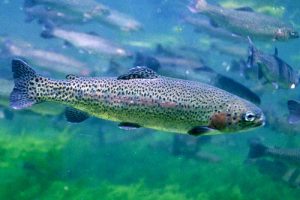Minnesota Department of Natural Resources (DNR) recently announced that the agency has stocked fall fingerling steelhead in Lake Superior and two rivers along the North Shore.
In 2017, Minnesota DNR began raising steelhead trout to bolster the population of these types of fish in streams along the North Shore of Lake Superior and in Lake Superior itself.
The program began with the intent to raise “clipped-for-harvest” fish, which means only fish with a clipped adipose fin can be kept by anglers. The adipose fin is a small fin on the back of the fish between the dorsal (large fin on the back of the fish) and caudal fin (tail fin).
With multiple fish being more than 5 years old now, the program is working with fully matured adults in prime reproduction age. Female fish are producing more eggs than in previous years and reproduction is exceeding expectations.
The program goals were set by DNR’s’ Lake Superior fisheries staff and, compared to those goals, a surplus of steelhead were produced.
DNR used this surplus of steelhead juveniles, which will be of harvestable age in the coming years, to increase populations along Minnesota’s north shore of Lake Superior.
Juvenile steelhead were stocked in the following areas:
Lake Superior at Two Harbors – 63,000 fall fingerlings
Sucker River – 62,000 fall fingerlings
Knife River – 14,000 spring yearlings
Stream conditions have been unfavorable for steelhead to naturally produce due to a five-year drought and flood cycle, which caused populations to drop by at least 50-80%.
“We’re excited because this is the first year the broodstock we have been developing is not only meeting our quota, but also exceeding our expectations,” said Cory Goldsworthy, Lake Superior Fisheries supervisor. “Given the low population of steelhead in our streams and Lake Superior, our surplus of fish couldn’t have come at a better time.”
The success of this program led to conversations with stakeholders about how to best utilize future broodstock, where to stock them, and a potential to focus on other species, like native brook trout. This information will also help to update the DNR’s Lake Superior fisheries management plan.
For more information visit the Minnesota DNR website (www.dnr.state.mn.us).
source: Minnesota Department of Natural Resources
